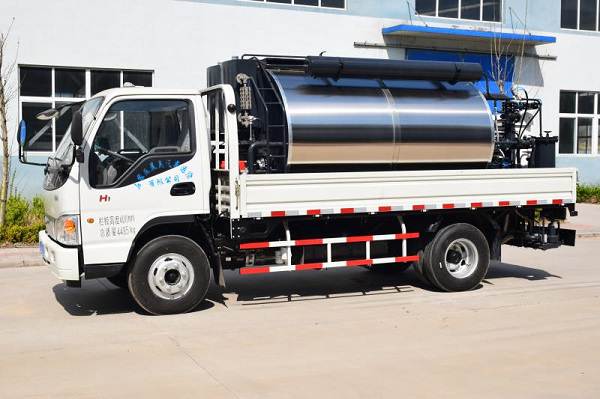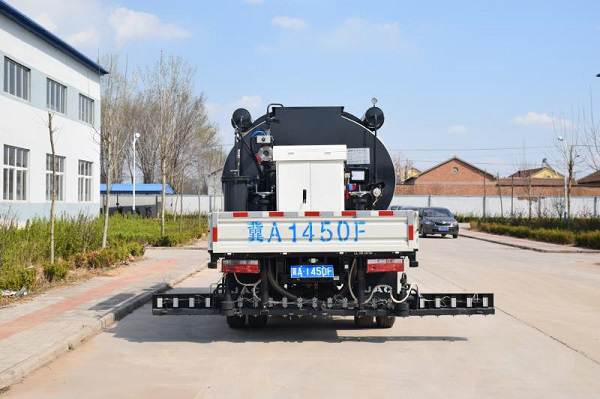Asphalt spreading trucks are used in highway construction and highway maintenance projects. They can be used for upper and lower seals, permeable layers, waterproof layers, bonding layers, asphalt surface treatment, asphalt penetrating pavements, fog seals, etc. on different grades of highway pavements. During project construction, it can also be used to transport liquid asphalt or other heavy oil.
Asphalt spreading trucks are used to spread the permeable oil layer, waterproof layer and bonding layer of the bottom layer of asphalt pavement on high-grade highways. It can also be used in the construction of county and township-level highway asphalt roads that implement layered paving technology. It consists of car chassis, asphalt tank, asphalt pumping and spraying system, thermal oil heating system, hydraulic system, combustion system, control system, pneumatic system and operating platform.


Proper operation and maintenance of asphalt spreading trucks can not only extend the service life of the equipment, but also ensure the smooth progress of the construction project. So what issues should we pay attention to when operating asphalt spreading trucks?
1. Before use, please check whether the position of each valve is correct and make preparations before operation. After starting the motor of the asphalt spreading truck, check the four thermal oil valves and air pressure gauge. After everything is normal, start the engine and the power take-off starts to work. Try running the asphalt pump and circulate it for 5 minutes. If the pump head shell is in trouble, slowly close the thermal oil pump valve. If the heating is insufficient, the pump will not rotate or make noise. You need to open the valve and continue to heat the asphalt pump until it can work normally. During operation, the asphalt liquid must maintain an operating temperature of 160~180℃ and cannot be filled. Too full (pay attention to the liquid level pointer during the process of injecting asphalt liquid, and check the tank mouth at any time). After the asphalt liquid is injected, the filling port must be closed tightly to prevent the asphalt liquid from overflowing during transportation.
2. During operation, the asphalt may not be pumped in. In this case, it is necessary to check whether the interface of the asphalt suction pipe is leaking. When the asphalt pump and pipeline are blocked by condensed asphalt, you can use a blowtorch to bake it. Do not forcefully turn the pump. When baking, be careful to avoid directly baking ball valves and rubber parts.
3. When spraying asphalt, the car keeps traveling at a low speed. Do not step on the accelerator hard, otherwise it may cause damage to the clutch, asphalt pump and other components. If you are spreading 6m wide asphalt, you should always pay attention to the obstacles at both ends to prevent collision with the spreader pipe. At the same time, the asphalt should be kept in a large circulation state until the spreading operation is completed.
4. After every day's operation, if there is any remaining asphalt, it must be returned to the asphalt pool, otherwise it will condense in the tank and make it impossible to operate next time.
 Albanian
Albanian  Russian
Russian  Arabic
Arabic  Amharic
Amharic  Azerbaijani
Azerbaijani  Irish
Irish  Estonian
Estonian  Odia (Oriya)
Odia (Oriya)  Basque
Basque  Belarusian
Belarusian  Bulgarian
Bulgarian  Icelandic
Icelandic  Polish
Polish  Bosnian
Bosnian  Persian
Persian  Afrikaans
Afrikaans  Tatar
Tatar  Danish
Danish  German
German  French
French  Filipino
Filipino  Finnish
Finnish  Frisian
Frisian  Khmer
Khmer  Georgian
Georgian  Gujarati
Gujarati  Kazakh
Kazakh  Haitian Creole
Haitian Creole  Korean
Korean  Hausa
Hausa  Dutch
Dutch  Kyrgyz
Kyrgyz  Galician
Galician  Catalan
Catalan  Czech
Czech  Kannada
Kannada  Corsican
Corsican  Croatian
Croatian  Kurdish (Kurmanji)
Kurdish (Kurmanji)  Latin
Latin  Latvian
Latvian  Lao
Lao  Lithuanian
Lithuanian  Luxembourgish
Luxembourgish  Kinyarwanda
Kinyarwanda  Romanian
Romanian  Malagasy
Malagasy  Maltese
Maltese  Marathi
Marathi  Malayalam
Malayalam  Malay
Malay  Macedonian
Macedonian  Maori
Maori  Mongolian
Mongolian  Bengali
Bengali  Myanmar (Burmese)
Myanmar (Burmese)  Hmong
Hmong  Xhosa
Xhosa  Zulu
Zulu  Nepali
Nepali  Norwegian
Norwegian  Punjabi
Punjabi  Portuguese
Portuguese  Pashto
Pashto  Chichewa
Chichewa  Japanese
Japanese  Swedish
Swedish  Samoan
Samoan  Serbian
Serbian  Sesotho
Sesotho  Sinhala
Sinhala  Esperanto
Esperanto  Slovak
Slovak  Slovenian
Slovenian  Swahili
Swahili  Scots Gaelic
Scots Gaelic  Cebuano
Cebuano  Somali
Somali  Tajik
Tajik  Telugu
Telugu  Tamil
Tamil  Thai
Thai  Turkish
Turkish  Turkmen
Turkmen  Welsh
Welsh  Uyghur
Uyghur  Urdu
Urdu  Ukrainian
Ukrainian  Uzbek
Uzbek  Spanish
Spanish  Hebrew
Hebrew  Greek
Greek  Hawaiian
Hawaiian  Sindhi
Sindhi  Hungarian
Hungarian  Shona
Shona  Armenian
Armenian  Igbo
Igbo  Italian
Italian  Yiddish
Yiddish  Hindi
Hindi  Sundanese
Sundanese  Indonesian
Indonesian  Javanese
Javanese  Yoruba
Yoruba  Vietnamese
Vietnamese  Hebrew
Hebrew  Chinese (Simplified)
Chinese (Simplified)







